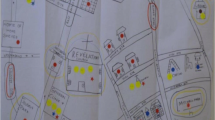Abstract
This study explored how young boys and girls living in low income urban neighborhoods defined and described reasons associated with youth violence. Five focus groups were conducted with 29 youth between the ages of 8 and 12 recruited from four selected study neighborhoods. Participants were asked to describe youth violence. Appropriate probes were used to explore similarities and differences by gender with regard to the reasons for violence. Definitions of youth violence were consistent across participants and included verbal threats, physical contact, and often the use of a weapon. Several common reasons for violence were found among both boys and girls; romantic relationships, respect, idle time, gangs.cliques, and witnessing violence. Reasons for violence unique to boys include fighting about issues related to money and illicit drugs. Gossip was identified as a reason specific to why girls engage in violence. Youth violence was perceived as a common problem impacting the lives of the boys and girls in this study. Although many of the reasons identified for violence are similar among boys and girls, select gender differences do exist. Future research and prevention efforts to address youth violence should engage young people in efforts to understand and address this important public health topic.
Similar content being viewed by others
References
Rivara FP. Understanding and preventing violence in children and adolescents. Arch Pediatr Adolesc Med. 2002;156:746–747.
Freudenberg N, Roberts L, Richie BE, Taylor RT, McGillicuddy K, Greene MB. Coming up in the boogie down: the role of violence in the lives of adolescents in the South Bronx. Health Educ Behav. 1999;26:788–805.
Horatio Alger Association of Distinguished Americans. The State of Our Nation’s Youth: 1998–1999. Alexandria, VA: Horatio Alger Association of Distinguished Americans; 1998. Available at: http://www.horatioalger.com/pdfs/state99.pdf. Accessed June 2, 2005.
Gelles R. Violence towards young children, violence in the family, violence in the community. Paper presented at: A Colorado State University Cooperative Extension Agent In-Service, Denver Colorado; 1998. In Fetsch RJ, Silliman B. Which Youth Violence Prevention Programs Work? The Forum for Family and Consumer Services. 2002;7(1). Available at: http://www.ces.ncsu.edu/depts./fes/pub/2002w/fetsch.html. Accessed June 2, 2005.
Richters JE. Community violence and children’s development: toward a research agenda for the 1990s. Psychiatry. 1993;56:3–6.
Anderson RN, Smith BL. Deaths: leading causes for 2001. Natl Vital Stat Rep. 2003;52:1–86.
Centers for Disease Control and Prevention. Web-based injury statistics query and reporting system (WISQARS). Available at: http://www.cdc.gov/ncipc/wisquars. Accessed July 6, 2004.
Centers for Disease Control and Prevention. Nonfatal physical assault—related injuries treated in hospital emergency departments—United States, 2000. MMWR Morb Mortal Wkly Rep.. 2002;51:460–463.
Chesney-Lind M, Belcamp J. Trends in delinquent girls’ aggressive and violent behavior: a review of the evidence. In: Putallaz, M, Bierman, P, eds. Aggression, Antisocial Behavior and Violence Among Girls: A Developmental Perspective. New York, NY: Guilford Press. 2004;203–220.
National Center for Injury and Prevention Control—CDC. Youth violence: the problem and overview of CDC’s efforts. Available at: http://www.cdc.gov/ncipc/factsheets/yvoverview.htm. Accessed December 21, 2003.
World Health Organization. Youth violence. Available at: http://www.who.int/violence―injury―prevention/violence/youth―violence/en. Accessed July 6, 2004.
Satcher D. US Surgeon General’s report in youth violence, 2001. Available at: http://www.surgeongeneral.gov/library/youthviolence. Accessed December 7, 2004.
Minkler M. Using participatory action research to build healthy communities. Public Health Rep. 2000;115:191–197.
Anderson E. Code of the Street: Decency, Violence and the Moral Life of the Inner City. New York, NY: Norton; 1999.
Earls FJ. Violence and today’s youth. Future Child. 1994;4:4–23.
Prothrow-Stith D, Spivak HR. Murder Is No Accident: Understanding and Preventing Youth Violence in America. San Francisco, CA: Jossey-Bass; 2004.
Knox M, Carey M, Kim WJ. Aggression in adolescents: the effects of gender and depression. Youth Soc. 2003;35:226–242.
Ness CD. Why girls fight: female youth violence in the inner city. Ann Am Acad Pol Soc Sci. 2004;595:32–48.
Weiler J. Girls and violence. New York, NY: Institute for Urban Minority Education; 1999. ERIC Digest, No. 143.
Snyder H. Juvenile Arrests 2000. Washington, DC: Office of Juvenile Justice and Delinquency Prevention; 2003. Available at: http://www.ncjrs.org/pdffiles1/ojjdp/191729.pdf. Accessed June 2, 2005.
Snyder H. Juvenile Arrests 2001. Washington, DC: Office of Juvenile Justice and Delinquency Prevention; 2003. Available at: http://www.ncjrs.org/pdffiles1/ojjdp/201370.pdf. Accessed June 2, 2005.
Data compiled by author. Maryland Department of Planning, 301 N. Preston St., Suite, 1101. Baltimore, MD 2003, 21201–22303.
Bernard HR. Social Research Methods: Qualitative and Quantitative Approaches. Thousand Oaks, CA: SAGE Publications; 2003.
N Vivo [computer program]. Version 2.0. Melbourne, Australia: QSR International; 2000.
Whitehead TL, Paterson J, Kaljee L. The “hustle”: socioeconomic deprivation, urban drug trafficking, and low-income, African-American male gender identity. Pediatrics. 1994;93:1050–1054.
Rich JA, Stone DA. The experience of violent injury for young African-American men: the meaning of being a “sucker”. J Gen Intern Med. 1996;11:77–82.
Reese LE, Vera EM, Thompson K, Reyes R. A qualitative investigation of perceptions of violence risk factors in low-income African American children. J Clin Child Psychol. 2001;30:161–171.
Chesney-Lind M, Koo J, Kata D, Fujiwara K. Girls at Risk: An Overview of Gender-Specific Programming Issues and Initiatives. University of Hawaii at Manoa: Social Science Research Institute, Center for Youth Research; 1998. Report No. 394.
United States Department of Justice, Bureau of Justice Statistics. Intimate partner violence and age of victim, 1993–1999. Available at: http://www.ojp.usdoj.gov/bjs/abstract/ipva99.htm. Accessed June 2, 2005.
Thorton TN, Craft CA, Dahlberg LL, Lynch BS, Baer K. Centers for Disease Control and Prevention. Best Practicing for Youth Violence Prevention: A Sourcebook for Community Action (Rev). Atlanta, GA: Centers for Disease Control and Prevention, National Center for Injury Control and Prevention; 2002.




